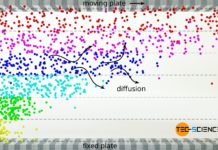The pressure at a certain depth of a liquid, which is caused by the weight of the liquid column above it, is referred to as hydrostatic pressure!
Introduction
In the same way as the particles in gases exert a pressure on interfaces, the particles in liquids also exert a pressure. Compared to a gas, however, a liquid has a relatively high density. In practice, this leads to a special phenomenon: the pressure in liquids increases more and more with increasing depth. This is due to the liquid column lying above the considered depth, which exerts an additional force due to its weight. In principle, this can be regarded as the contact pressure of the liquid column. In technical terminology, this pressure of a liquid due to its weight is called hydrostatic pressure.
Derivation of the hydrostatic pressure
The contact pressure
In order to better understand the formation of the hydrostatic pressure, a cylindrical ice block with a cross-sectional area A is first considered. This ice column has a certain mass m and thus also a certain weight FG=m⋅g. With this weight the ice column presses on the ground underneath it. The contact pressure caused by the ice column is calculated from the quotient of the weight and the contact surface area according to the definition of the pressure:
\begin{align}
\label{p}
&p =\frac{F_G}{A}= \frac{m \cdot g}{A} \\[5px]
\end{align}

Based on this formula, one might think at this point that the contact pressure depends on the cross-sectional area. But this is not the case! If the cross-sectional area of the ice column is doubled at the same height, the mass is also doubled. So the denominator in equation (\ref{p}) increases in the same way as the numerator. The quotient therefore remains constant. At this point one can imagine the thick ice column simply as two thin ice columns. Each of the halves causes the same contact pressure, no matter if they are considered separately or as a whole.
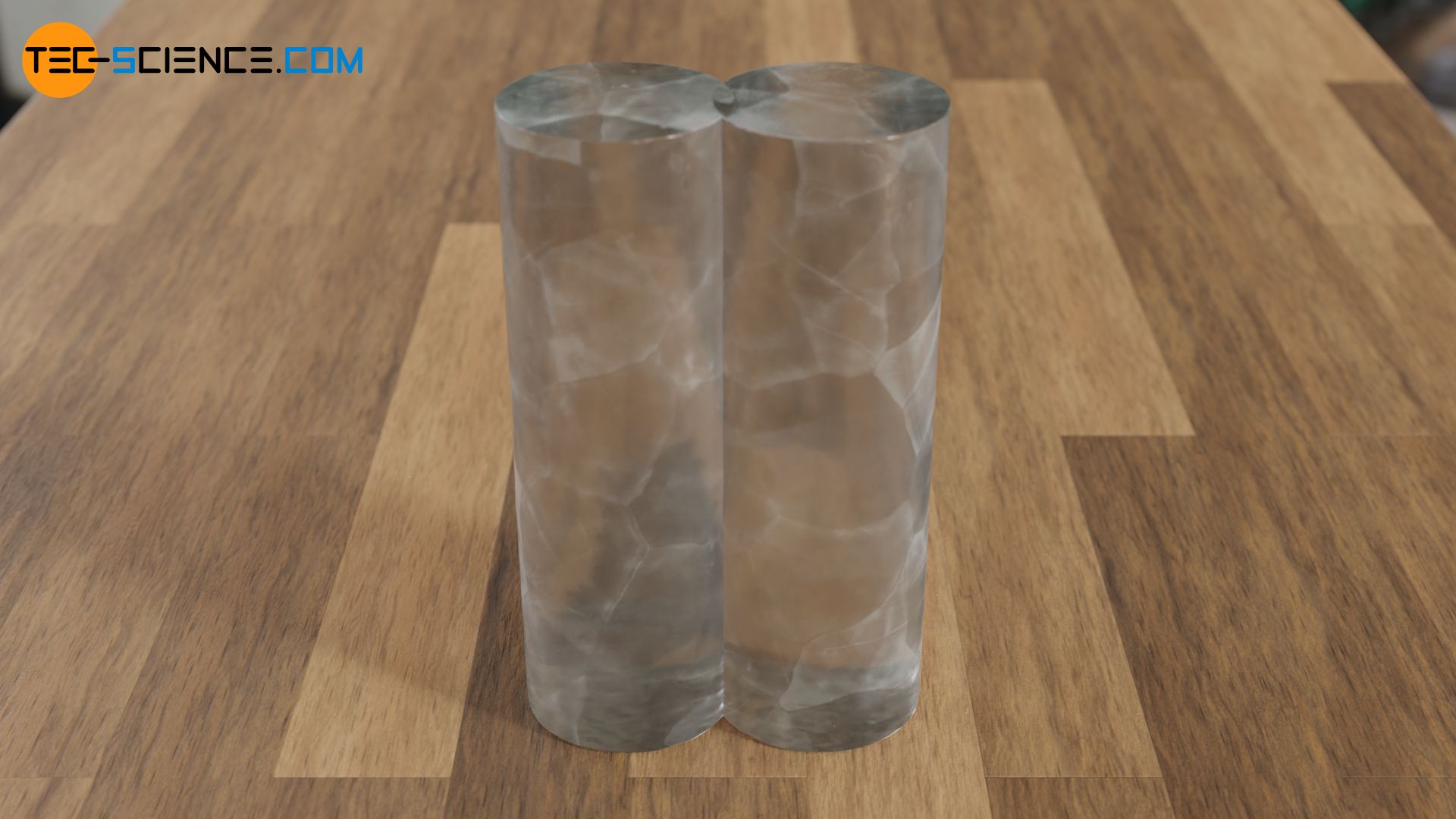
The independence of the contact pressure from the contact surface area can also be shown mathematically. For this the mass of the ice column is expressed by the density ϱ and its volume V (m=V⋅ϱ), whereby the volume can be calculated by the cross-sectional area A and the height h of the ice column (V=A⋅h):
\begin{align}
\label{m}
&m = V \cdot \rho = A \cdot h \cdot \rho \\[5px]
\end{align}

If equation (\ref{m}) is now used in equation (\ref{p}), it becomes clear that the contact pressure is independent of the contact surface area and depends only on the density of the ice and the height of the ice column:
\begin{align}
\require{cancel}
&p =\frac{m \cdot g}{A} = \frac{ \bcancel{A} \cdot h \cdot \rho \cdot g}{\bcancel{A}} \\[5px]
\label{pp}
&\underline{p = h \cdot \rho \cdot g} \\[5px]
\end{align}
From contact pressure to hydrostatic pressure
In principle, the ice column can also be enclosed in a cylindrical container. This will not change the contact pressure with which the ice presses against the bottom of the container. In a further step, the ice can also be melted. This also does not change the contact pressure, since the mass of the water is not changed during melting. The weight with which the water presses on the bottom of the vessel is therefore still the same and leads according to equation (\ref{p}) to the same contact pressure (note that during melting the density of the water increases, but as a result the height of the water column decreases).

The pressure at the bottom of the container is thus caused by the weight of the water column above it, regardless of whether it is frozen or not! This pressure in a liquid, which is caused by the liquid column above, is also called hydrostatic pressure ph:
\begin{align}
\label{h}
&\boxed{p_h = h \cdot \rho \cdot g} ~~~\text{hydrostatic pressure} \\[5px]
\end{align}
The pressure at a certain depth of a liquid, which is caused by the weight of the liquid column above it, is referred to as hydrostatic pressure!
As already explained in detail in the context of contact pressure, the hydrostatic pressure does not depend on the size of the cross-sectional area of the liquid column. The hydrostatic pressure only depends on the height of the liquid column!
The hydrostatic pressure only depends on the height of the liquid column!
Effect of hydrostatic pressure compared to contact pressure
The hydrostatic pressure of a liquid obviously does not differ in magnitude from the contact pressure of a frozen liquid, but there is a difference. This can be seen by placing an inflated balloon at the bottom of the vessel.

In the case of the ice column, the resulting contact pressure acts only downwards and compresses the balloon in height. The hydrostatic pressure of the liquid, on the other hand, acts equally in every direction (see also article Pressure). In this case, the balloon is compressed evenly from all sides!
The fact that the pressure in liquids (or gases) has the same effect in all directions is also shown by the fact that water in a container is even pressed out sideways through an outlet, although the weight of the water column acts downwards.
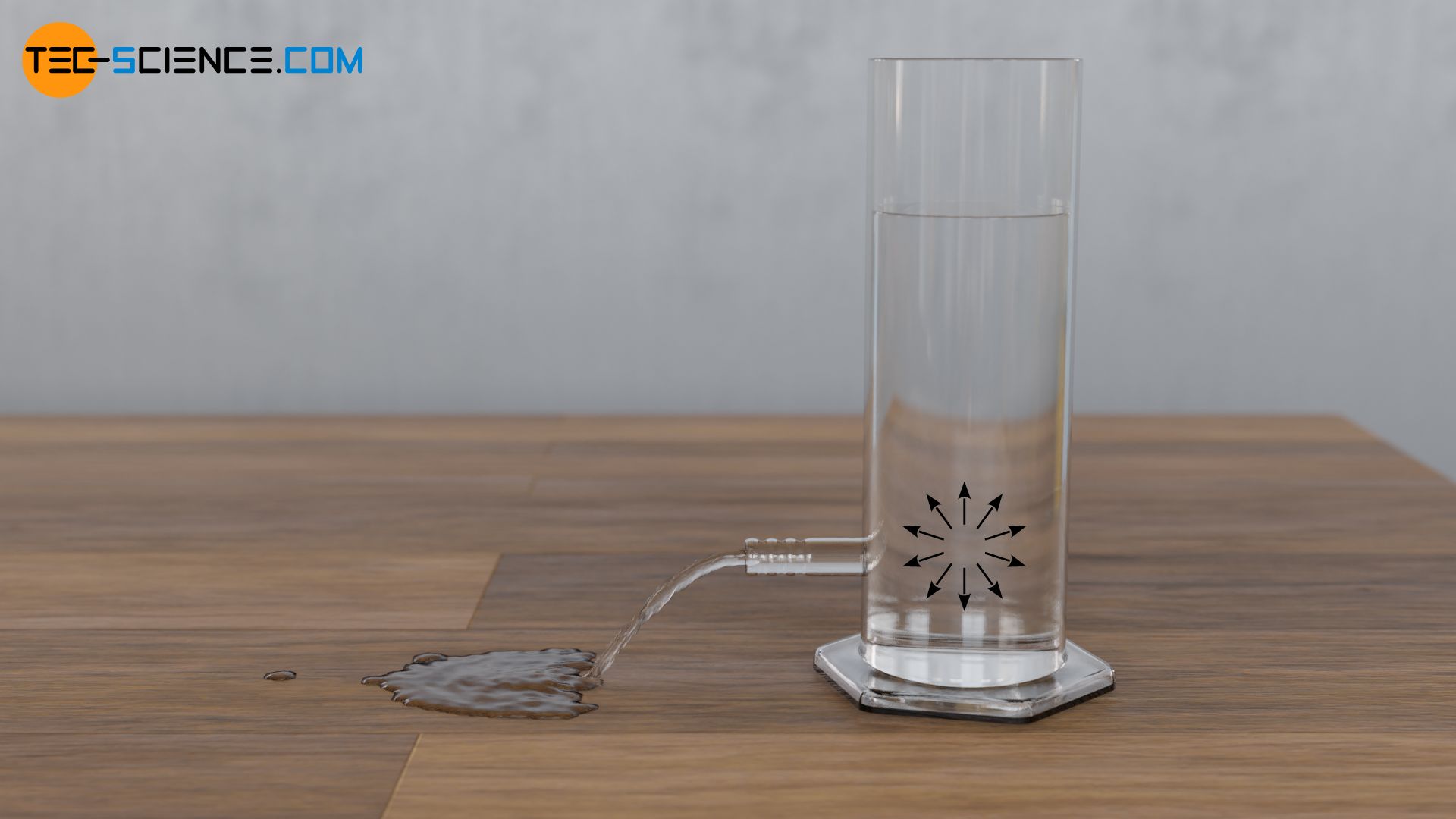
Dependence of hydrostatic pressure on depth
Hydrostatic pressure can be found not only at the bottom of a liquid, but at any height or depth. Again, one can imagine that the liquid column above the considered depth is frozen. This in turn clearly leads to a contact pressure with which the frozen column presses on the liquid column below. Now one lets the frozen column melt again in thought, which does not change the existing pressure at the considered depth. Thus in equation (\ref{h}) the height h of the liquid column can be interpreted as the depth below the surface of the liquid.
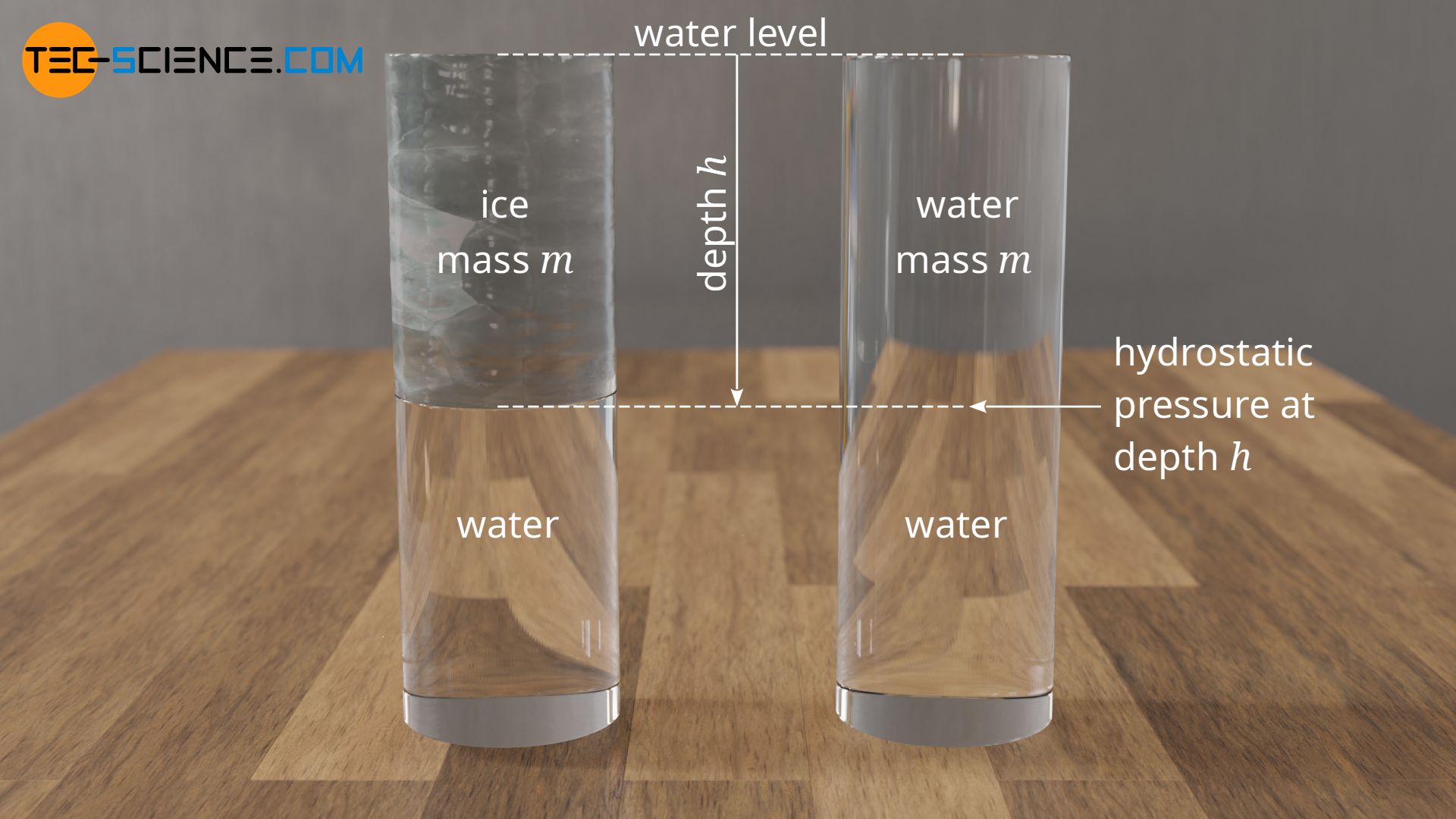
The fact that the hydrostatic pressure increases with increasing depth can be clearly demonstrated. A vessel is filled with water for this purpose. Outlets through which the water can flow out are placed at different heights. One can now clearly see that the water flows out more strongly with increasing depth. This is due to the increasing water pressure due to the hydrostatic pressure, which presses the water out at a higher speed. If pressure gauges are attached to the outlets, the pressure can also be measured.
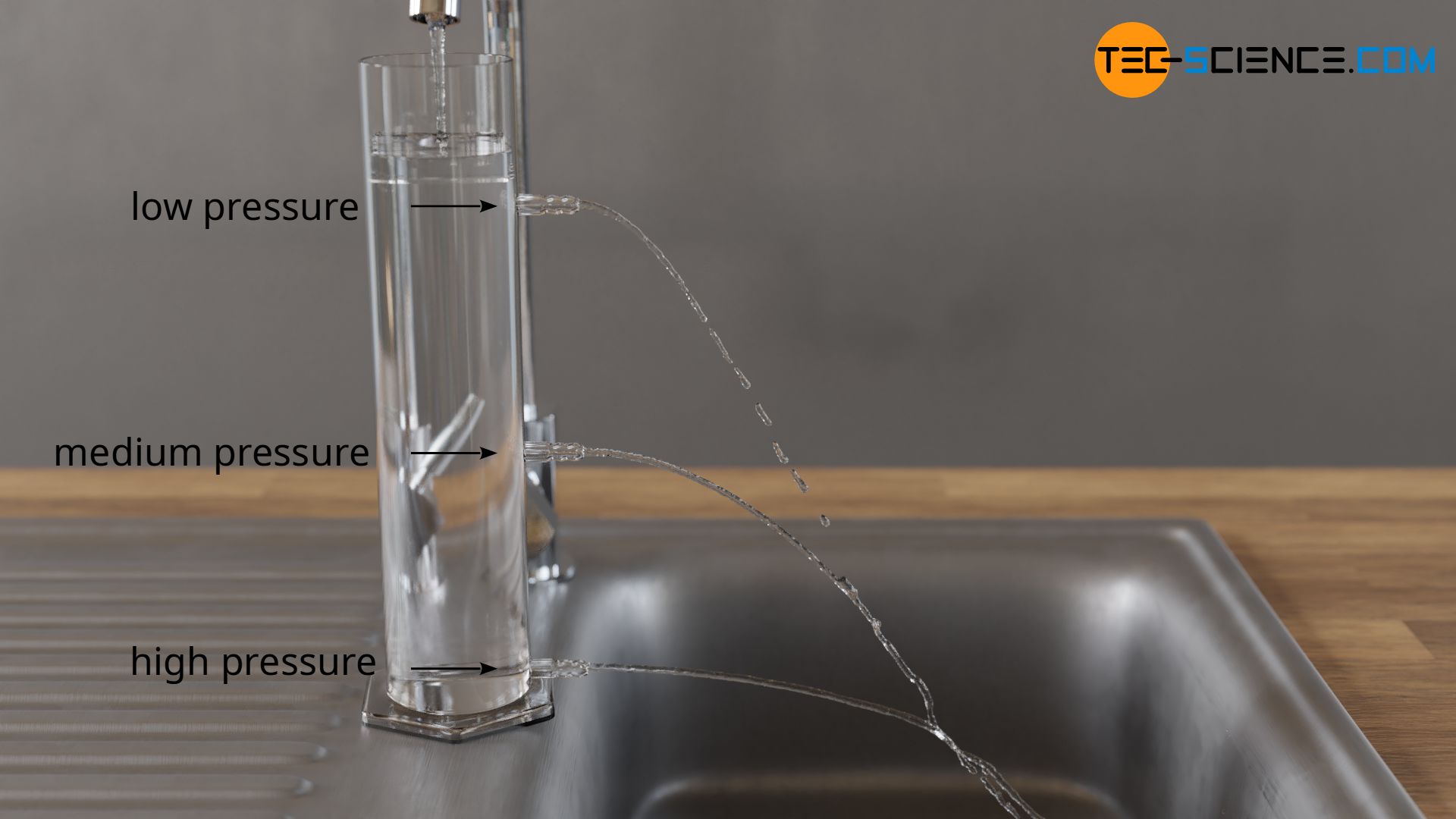
It should always be kept in mind that the absolute pressure at a certain depth is not only determined by the hydrostatic pressure. After all, it is not only the weight of the water column that causes the pressure, but also the atmospheric pressure acting on the water surface. The absolute pressure p at a certain depth thus results from the sum of the ambient pressure p0 and the hydrostatic pressure ph. This is often referred to as Pascal’s law or hydrostatic equation.
\begin{align}
&\boxed{p = p_0 + p_h} ~~~\text{absolute pressure} \\[5px]
\end{align}

Hydrostatic paradox
It has already been explained that the cross-sectional area of a liquid column has no influence on the hydrostatic pressure. The fact that not only the size but also the shape of the container has no influence will be shown experimentally and theoretically in the following.
The figure below shows three containers with different shapes. The containers are each filled with water, whereby the filling height is identical in all cases. The area of the container bottoms is also the same in all cases. The hydrostatic pressures at the bottom can be compared by means of attached pressure gauges. Thus, the influence of the shape of the water column on the hydrostatic pressure can be examined.
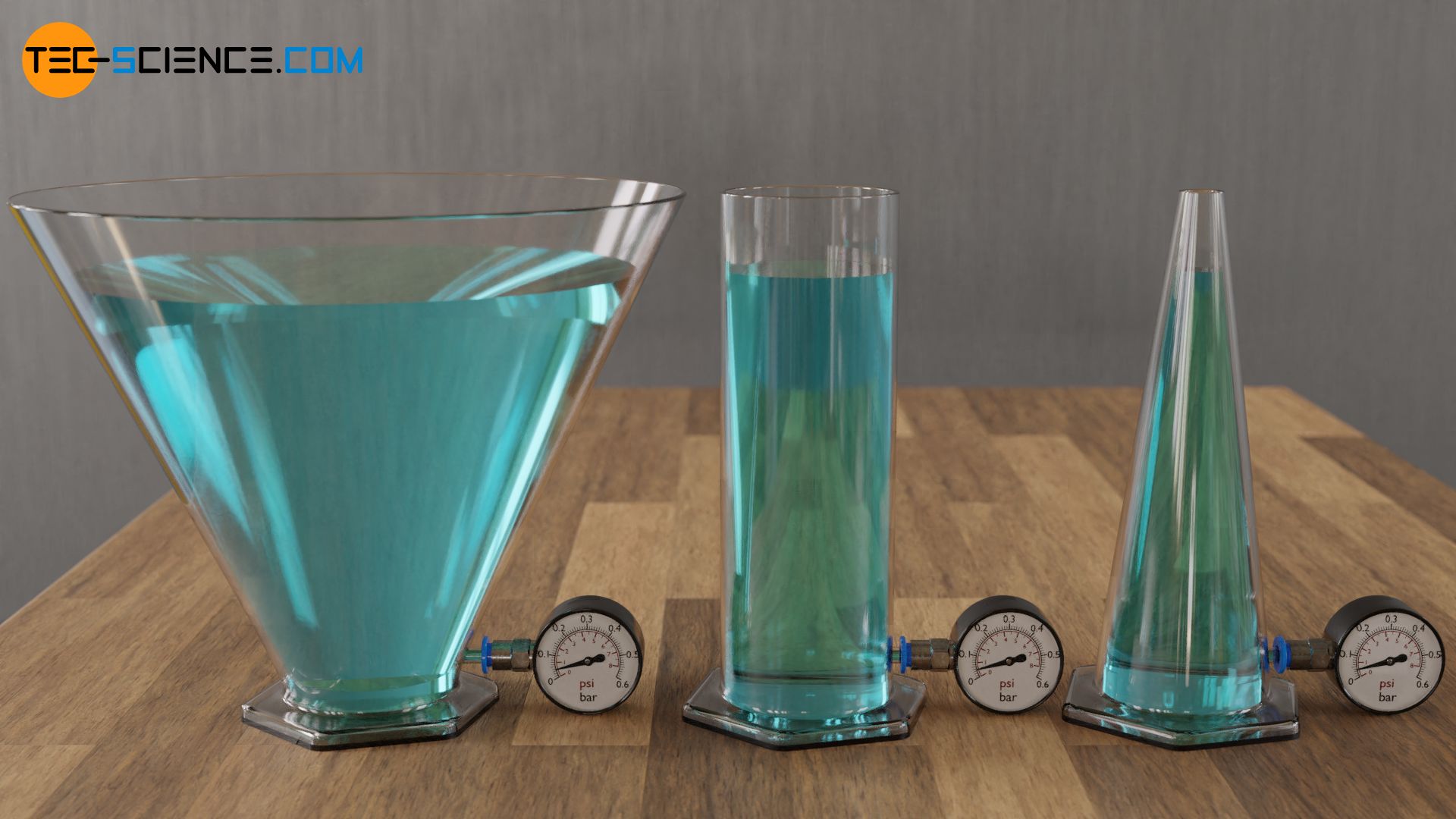
One could now think that the hydrostatic pressure in the left container is highest due to the greater amount of water. Paradoxically, the pressure gauges all show the same value. Obviously the shape of the container has no influence on the hydrostatic pressure. This is also the reason why the same water levels are found everywhere in connected containers. Due to this fact, vessels that are in contact with each other via pipes are also referred to as communicating vessels. More information and a mathematical derivation can be found in the article Applications and examples of hydrostatic pressure.
The shape of the container has no influence on the hydrostatic pressure in the liquid!
At first glance, this may seem surprising, but the law of conservation of energy can be used to explain this phenomenon vividly. If the shape of the vessel had an influence on the hydrostatic pressure, then the law of conservation of energy would be violated, as the following thought experiment shows.
Energetic Consideration
Imagine the two differently shaped containers. If the shape of the container had an influence on the hydrostatic pressure, then the water pressure in one of the vessels would be greater than in the other at a common depth. If the two vessels were connected at this depth by a tube, the greater water pressure in one of the vessels would cause the water in the other vessel to be pushed upwards.
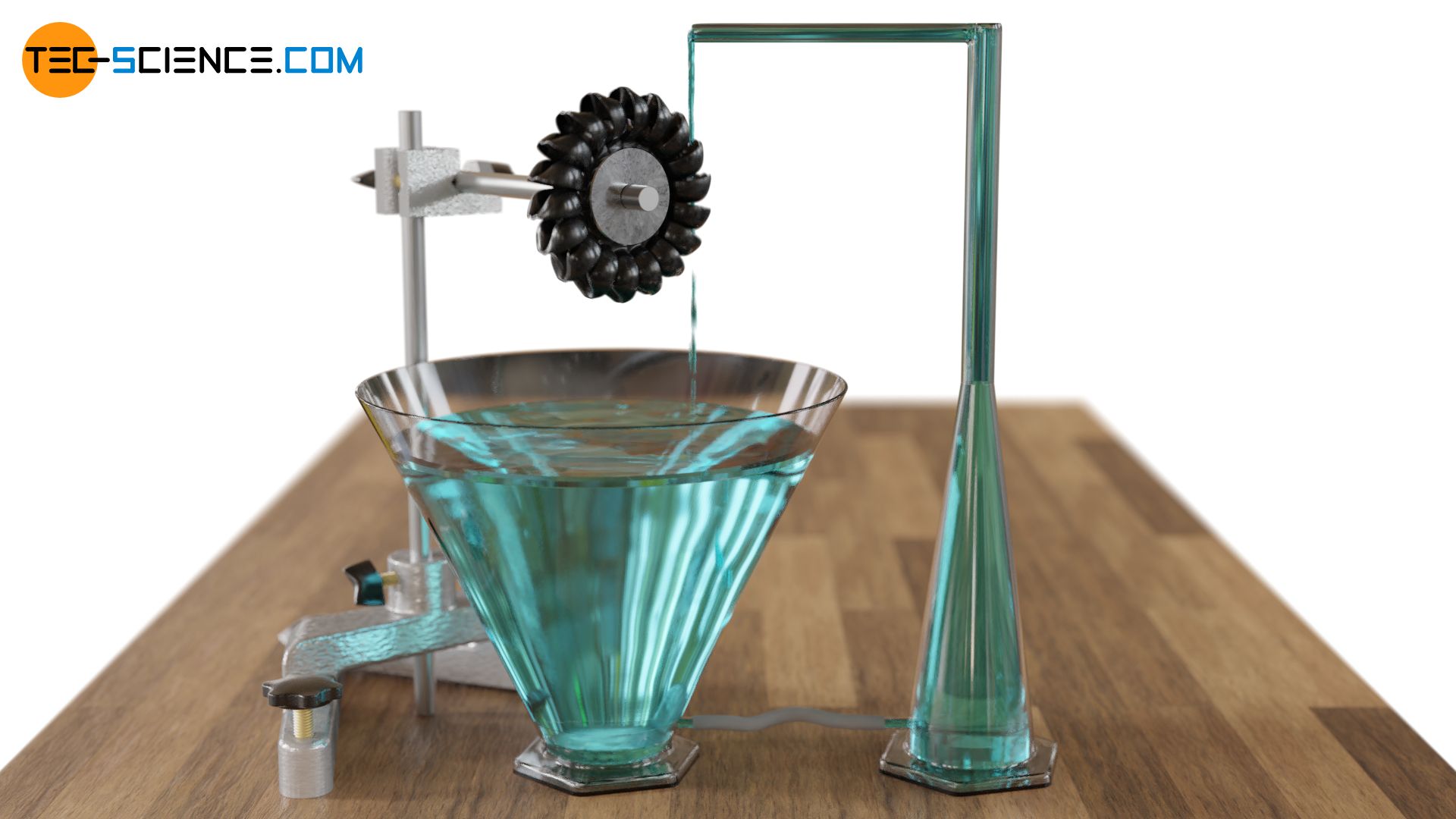
As a result, there would be a difference in the water levels. The water pushed upwards could now be let flow by a small water turbine back into the container with the higher hydrostatic pressure. The cycle would start again from the beginning. So turbine would run by itself and would produce energy out of nothing. Such a perpetual motion machine however contradicts the law of energy conservation. At this point it becomes clear that the shape of the container obviously has no influence on the hydrostatic pressure for energetic reasons.
Consideration with a balance of forces
The fact that the shape of the water column has no influence on the water pressure can also be shown by means of a equilibrium of forces. The water in the funnel-shaped vessel has a greater mass and thus a greater weight, but part of the weight is compensated by the sloping vessel walls. If one imagines the water frozen again at this point, then it becomes immediately clear that the walls obviously exert a supporting force and keep the frozen water in the container despite possibly open bottom.

Even in the liquid state, the container wall keeps the water masses (m) in balance with an upwardly directed supporting force Fs. Thus, not the entire weight of the water rests on the ground, but only the water column above the bottom (the remaining weight is taken up by the vessel wall). Effectively speaking, one gets the same situation as in the case of the cylindrical container.
Also with the upward tapering container, supporting forces are responsible for the fact that the pressure at the bottom is larger than one could assume due to the relatively small amount of water. If one first considers only the water column below the container opening (hatched area in the left part of the figure below), then the hydrostatic pressure at any depth can be calculated as usual (ph=ϱ⋅g⋅h). This pressure acts equally in all directions. At the considered depth, this pressure thus also presses on the inclined container walls and thus generates a upward acting force Fh.
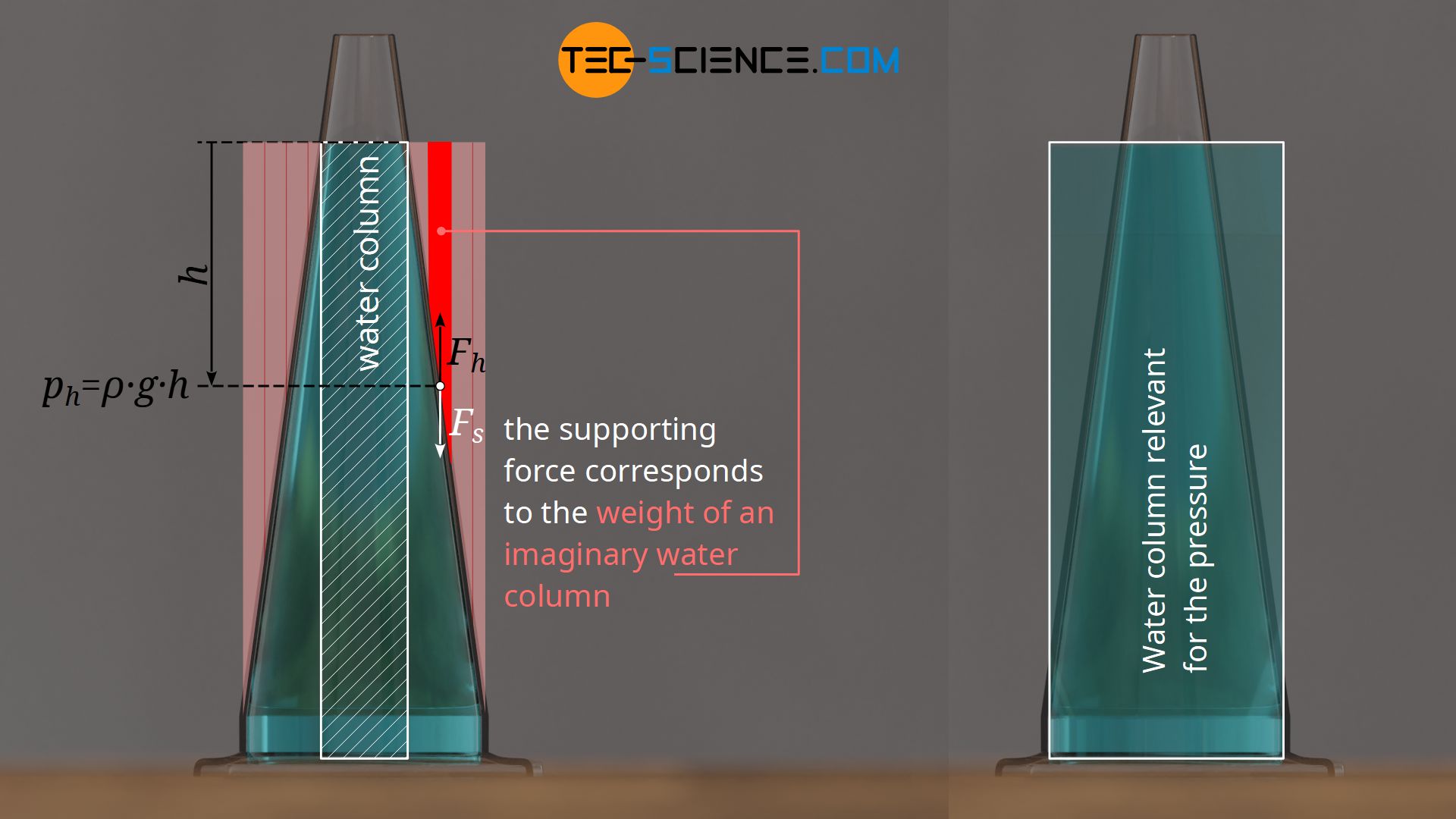
The fact that the water is pressed upwards can also be clearly understood. If holes were drilled in the wall of the container, the water would be pushed upwards and would flow out. But the walls of the container prevent this by a downward acting supporting force Fs, which is obviously as great as the upward force Fh caused by the water pressure. The water on the inclined vessel walls is thus subjected to a downward supporting force equal in magnitude to the weight of a water column above it. In fact, we are again dealing with a cylindrical water column, the diameter of which corresponds to the diameter of the bottom. The result is the same situation as in the case of the cylindrical vessel.
Influence of floating objects on the hydrostatic pressure
Not only the shape of the container, but also the placing of a floating object on the water surface has no influence on the calculation of the hydrostatic pressure accourding to equation (\ref{pp}). The figure below shows a vessel with water in which a floating ball is placed.

In fact, the hydrostatic pressure will increase due to the ball being placed on the water, as not only the weight of the water but also the weight of the ball becomes effective. However, the increased hydrostatic pressure can also be explained purely by the rise in the water level, which is connected with the floating ball.
The fact that the hydrostatic pressure is still only dependent on the water depth (which is now greater by placing the ball on it) does not change! This consideration finally leads to the so-called Archimedes’ principle, which states that the buoyancy of a floating body is just as great as the weight of the displaced liquid. More information can be found in the article Buoyancy.
Hydrostatic pressure is of great importance in everyday life and in technology. More information can be found in the article Applications and examples of hydrostatic pressure.






